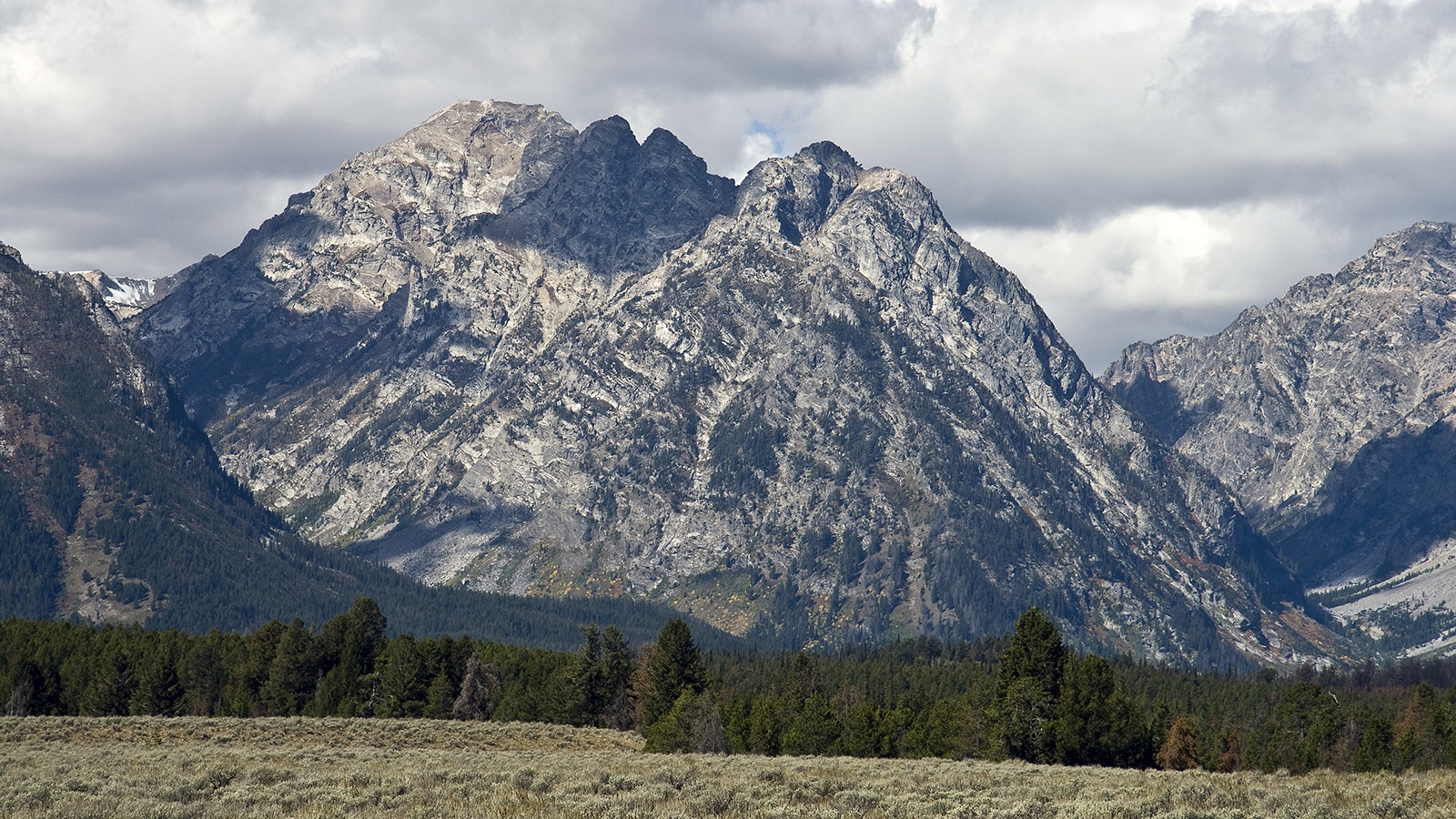The Wyoming Board on Geographical Names is considering a proposal to rename a prominent peak in the Grand Tetons honoring a man with a checkered past.
At its meeting next week, the board will consider a name change proposal for 11,595-foot Mount Woodring, named after Samuel Woodring, the first superintendent of Grand Teton National Park. The mountain is a prominent fixture of the Teton Range, located adjacent to the often-photographed Mount Moran.
In 1934, Woodring faced criminal charges, accused of attempting to rape an 11-year old girl, a charge that was subsequently dropped — but not before Woodring resigned from his position and left Teton County in disgrace.
Colorado resident Bruce Noble has submitted the proposal for the name change because of the charges brought against Woodring, requesting Mount Woodring be renamed to Raven Peak.
History Of the Name
Woodring became superintendent of Grand Teton park in 1929 and is largely known for his early efforts to build trails there and his work to establish the park.
According to a 2017 Jackson Hole News and Guide story, Woodring had previously been an Army ranger, packmaster, firefighter and chief ranger of Yellowstone, and rubbed shoulders with former presidents Teddy Roosevelt, Warren Harding and Calvin Coolidge.
In 1934, Woodring was charged in Teton County District Court with assault with intent to commit rape on an 11-year-old girl.
In his name change application, Noble provided court records from 1934 to prove that Woodring was charged with the crime, which was fully investigated. To collect this evidence, Noble had to make trips to the Wyoming State Archives and National Archives in Maryland.
The charges were eventually dropped against Woodring when the alleged victim's parents said they didn’t want to put their daughter through the trauma of testifying.
Concerning Allegations
In his application to change the mountain’s name, Noble also included a 1934 letter from Woodring’s secretary sent to the director of the National Park Service at the time, detailing an investigation that took place into the allegations against Woodring, which were found to be credible.
The secretary, H.M. Sherman, said they had heard a story from a trusted source about a young girl who said she had been sexually assaulted by Woodring at least six times.
Sherman also relayed another story brought to him by a park ranger about Woodring attempting to perform sexual acts on a 12-year-old girl. That girl had been afraid to tell her parents as her father worked for Woodring as a ranger.
After investigating further, Sherman and the park ranger found legitimacy with both claims.
The men brought their evidence to Fritiof Fryxell, Grand Teton’s first naturalist, who was “horrified” to learn the news and assisted with their investigation. Just four years previous, Fryxell had recommended that the mountain be named after Woodring.
When the father of the 11-year-old girl accused Woodring of sexually assaulting his daughter, the superintendent allegedly admitted to some guilt but denied committing rape.
But when the secretary directly questioned Woodring about the allegations, the superintendent said that in one instance one of the girls climbed into his lap, leading him to believe they wanted to engage in physical relations.
After the charges were filed, the secretary said Woodring changed his tune again, claiming he had been framed entirely. Woodring was arrested and pleaded not guilty to the charge, after which he was released on a $5,000 surety bond.
“These documents should demonstrate the offensive nature of the name Mount Woodring and the need to adopt a new name at the earliest possible opportunity,” Noble wrote in his name change proposal application.
Was Well-Known
Woodring resigned from his position and left Teton County, never to work in the Park Service again, said Shelley Messer, a natural resource analyst for the State Engineer's Office and a voting member of the Wyoming Board on Geographic Names. He died five years later.
“The community was well aware of what happened,” Messer said. “It kind of put a scarlet letter on his name.”
According to Noble, in the early 1960s, a small group of men launched an effort to name the mountain after Woodring while fully aware of the allegations made against him nearly 30 years prior. The Board of Geographic Names then approved the designation in 1963.
Messer said the name was likely only approved because of a lack of knowledge about Woodring’s past. Today, finding background information on people is much more readily available thanks to the internet and other resources.
“Back in the 1960s, they did not have what they had today,” she said. “I believe when they named it that they erred.”
Messer stressed that she’s only one member on the board, but plans to vote for the name change, as she was persuaded by the court records and Sherman’s letter. The fact that the charges were dropped makes no difference to her.
“I personally think the supporting documents are pretty persuasive,” she said.
She said her board has received very little public input on the name change and no feedback from the U.S. Forest Service or Teton County commissioners.
Because of the lack of feedback, Messer said she doesn’t anticipate her board taking a vote on the name change at its April 18 meeting.
Name It Raven
Noble said it’s safer to name the mountain after an animal like a raven rather than any person.
“The reputation of a person can change with the passage of time, whereas the status of a raven is not likely to change as years pass,” Noble writes. “The hope is that Raven Peak will have staying power that helps to make it a fitting name.”
Ravens are commonly found throughout Wyoming, and in particular the Tetons. There are a number of mountains named after ravens throughout the greater western United States, but none in Wyoming.
Sign Of The Times
There have been hundreds of name changes made to landmarks throughout the U.S. in recent years as a result of a greater recognition for past misdoings and wrongs committed by those who were honored.
Some have criticized this movement as an example of erasing or revising history.
The Wyoming board only makes recommendations on name changes, which it then provides to the U.S. Board on Geographic Names to make a final decision on.
The national board officially changed the name of Swastika Lake in Albany County in January after receiving a 4-3 recommendation from the Wyoming board.
Messer said her board is mostly split on the issue of name changes.
“There’s very much an aspect of this that says this is history complete, yes we should tell this history,” she said. “There’s also a contingency that says yes this is history, but not the history we should celebrate.”
In recent years, the Wyoming board has recommended name changes for a peak in Yellowstone National Park formerly named Mt. Doane, and Swastika Lake. The board has also rejected proposals for changes to the Hayden Valley in Yellowstone and a small mountain outside Cody that would have been named after the famous artist Jackson Pollock.
In 2022, the U.S. Department of Interior announced that it had assigned new names to 643 federal geographical locations nationwide and 41 on Wyoming federal lands that included the word “squaw.”
At their meeting April 18, the board will also consider a name change proposal for an unnamed creek in Natrona County to be named Porter Creek after a family that owned property along it. Messer said this proposal has been unopposed.
Leo Wolfson can be reached at leo@cowboystatedaily.com.





